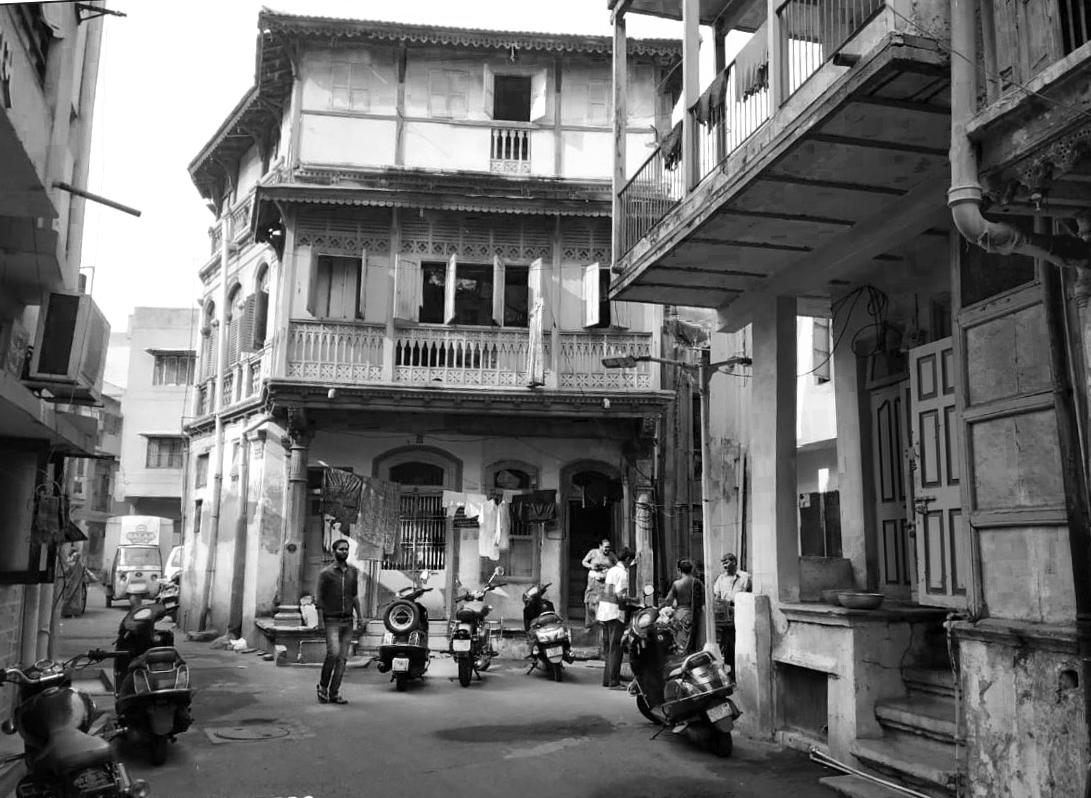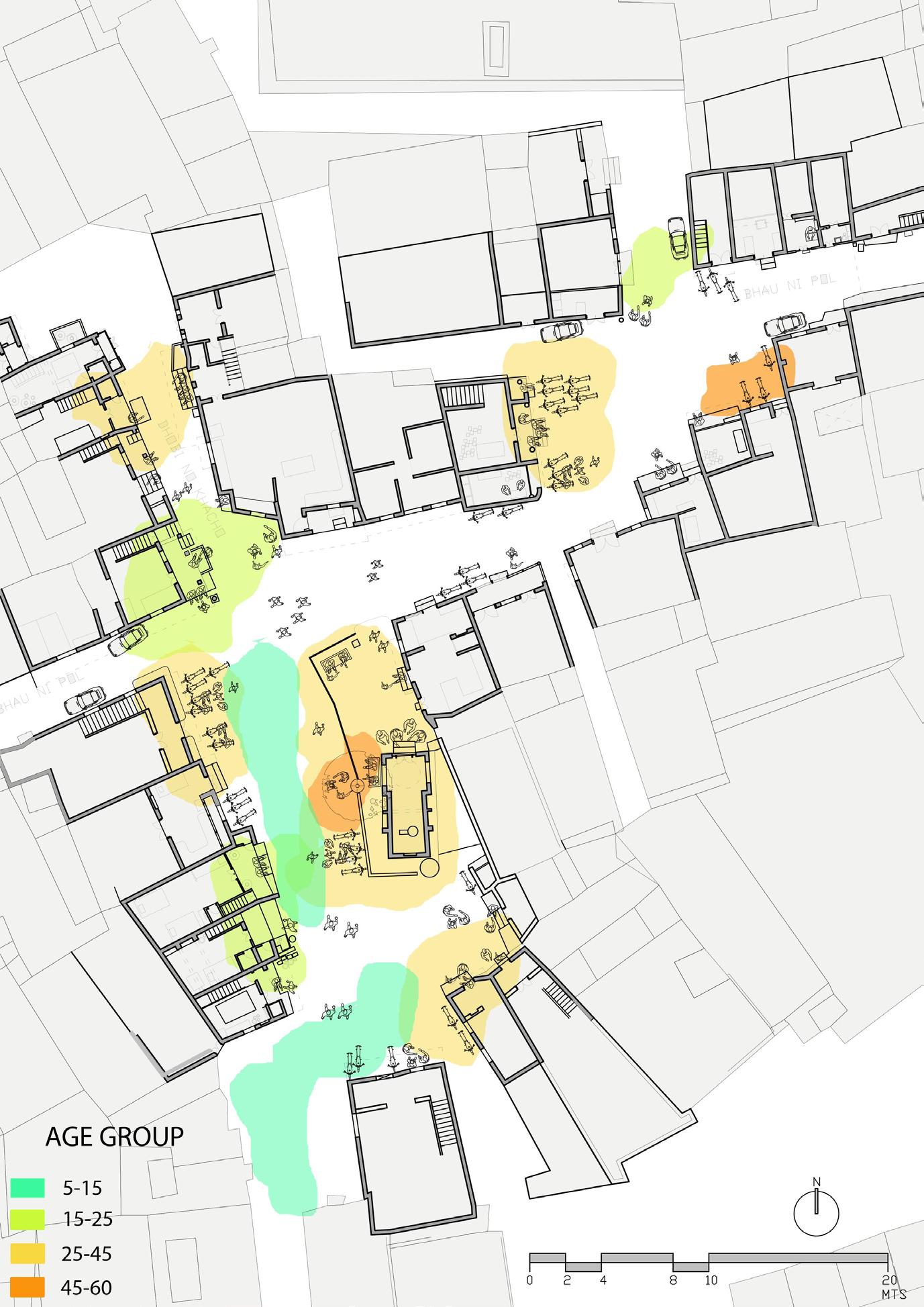
7 minute read
1.5 Activity pattern of the chowk
1.5
Activity pattern of the chowk
Advertisement
The usual daybreak of the residents starts by visiting the temple and offering water to the tree beside the temple. During that time an old lady sits there for a while with her neighbors and does her daily chants and performs her rituals. The street becomes and the chowk becomes alive early in the morning when cleaning and water filling activities start taking place. This is the time when usually women wash clothes or utensils and collect water from the chowkdi right in the early morning just beside the otla on the street edge (Kagal 1986). At times women also gives a bath to their young ones in the chowkdi itself. This is the time when maximum interaction within the women residents takes place. At the same time, visitors, as well as residents, visits the iron stall to give and take clothes for laundry and iron press. During this time either the elderly sitting in the otla or the men enjoy being a part of the street activities and experiencing the environment while reading the newspaper. One of the residents their shares his experience by saying that he enjoys sitting on the otla during the morning daybreak as he could listen to the sound of the bells at the temple nearby and hear the chantings performed by the devotees. At the same time, there is a sound created by the visitors to the place and a chance to exchange a casual talk with them happens. By the time vendors selling vegetables, fruits and flowers would come and will call to gather everyone at its pitch voice. This is the time when residents from the above floors come down to take vegetables and fall into a casual talk with the neighbors and other visitors. The vendor with fresh flowers sitting besides the temple and brewing tea at all the houses during day time evokes the smelling senses while reading a newspaper on the otla. All of these activities happening around the chowk and street makes a spectator feel to be indirectly participating in the activities and experiencing the atmosphere.
Morning Activities
Fig 10: Morning routine of wahing clothes at otla. (Raval 2017)
Fig 11: Visitor looking at the surrounding activities and structures. (Raval 2017)



Fig 13: Deactive space during noon hours (Raval 2017)

During noon the chowk becomes comparatively deactive, unless any commercial or retail activities takes place in the chow. This is the time when only passive activities such as parking takes place. Activities during noon are null and no residents come out to the chowk during this time. Also the otlas opening towards the main chowk are less and hence the open space is devoid of any shaded area to sit.

Fig 14: Plan of the chowk showing noon activities. (Raval 2019)
Evening activities
The chowk starts becoming active again at 6 pm onwards when children come out to ride bicycles and teenagers to chit chat. People usually don’t come out to interact as the number of sitting spaces are less. They tend to meet in the street besides (Dhobi no khancho) as there are more semi-private zones opening towards the street and the proportion of the street is intimate. This characteristic of the streets encourages and fosters interaction among the residents and makes one feel comfortable enough to be a part of that space.

Fig 15: Plan showning the activities during evening hours (Raval 2019)
Circulation in relation to the pause points:
Pedestrian movement and pause points are highly guide by the building territories and the vehicular movement. People prefer walking a bit away from the building territories, so that they do not hinder the privacy of other residents, but pauses in those buffer spaces acts as the interaction spots. People tend to pause and interact at places where the degree of safety is high, near sitting spaces and places with higher permeability.

Fig 16: Plan showing the circulation pattern and pause points of the users. (Raval 2019)

Physical density analysis
Fig 17: Physical density versus openness analysis of the chowk. (Raval 2019)

Higher density in the local area population physically facilitates a high level of interaction and activeness in the space. Due to high-density residents of the pol tend to move out to the shared spaces or junctions, due to the absence of open spaces where there is a probability of more face to face interaction. Even high density increases proximity within the neighbours, so even while passing through the street there are more chances of incidental meet and sharing favors. At the same time for the visitors, it certainly gives a sense of attachment to the place and feels to be a part of the community. The ratio of density versus openness in the chosen case is 1:3, where density is higher than the openness.
Fig 18: Desity of the chowk (Raval 2019)

Most active area in the chowk:
Fig 19: Men sitting at the birdfeeder and looking at the activites in the chowk (Raval 2017)

Maximum people tend to talk near the social amenities and sitting spaces (Temples, tea stall and shops). Other than that, they prefer interacting within the house boundaries (especially women). Maximum interaction happens on the edges of the buildings or street corners and away from the vehicular movement

Fig 20: highly active spots of the chowk. (Raval 2019)
Age group:
The age group of the users plays a crucial role in defining the character of a space as the need and the activity patterns also varies according to the age group. People with different age group have different mind sets and tend to find their comfort zone in open space depending on the activity choices they make. According to the observations based on the users of the space, the users were divided in the four categories of age, people ranging from the age of 5 to 15, 15 to 25, 25 to 45 and 24 to 60. To this the inferences were, that the children (5-15) tend to play in strategic spots where vehicular movement is less and places where the eyes of their guardian falls. People within the age group of 15 to 20 sit at the junctions or the nodal points of an opens space. Where they can see activities happening around them and participate in different activities. User group ranging from 25 to 45 years mostly seek interaction outside their work places, near their semi- private zones and users within 45- 60 tend to interact where the amount of sitting spaces are more as they try to seek more comfort while interacting. They also meet near social amenities like temple, grocery shop tea stall etc.
Fig 21: Plan showing the activities in relation to the age group (Raval 2019)

Activities from the floor above.

Fig 22: Visual connectivity and participation from the above floors (Raval 2019)

The diagram above shows the transparency of the buildings that allows visual connectivity in common space. The built form on all the sides of the chowk are mostly residential. So the built form opening towards the common chowk is more but sizes of the openings are small in case to maintain privacy from passersby. Whereas the visual connectivity is higher on above floors with balconies popping out, allowing to become the part of the activities happening in the chowk, this increases the chances of interaction. A person standing in the chowk can give a call by its pitch voice and can find chances to interact with the one standing on the balcony above.

Private SemiPrivate
Pedestrian Vehicular Public
parking
Fig 23: A section of the chowk showing the visual connectivity on ground floor (Raval 2019)
Private
The focal point of the chowk is the temple and is the main social amenity for the residents. The organization of the temple is such that it blocks the views of one side of the building edges, whereas on the other side people can easily see through the activities happening around the temple. The number of balconies popping out on one side of the chowk are more, so people usually stand in the balconies and be the part of the activities happening in the chowk. The visual connectivity is blocked by the temple but not the audibility. The height and the proportion of the buildings around are such that it encourages the quality of vertical interaction and also keeps the chowk shaded during morning and evening.





